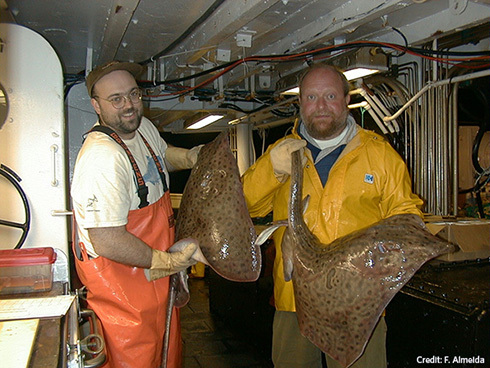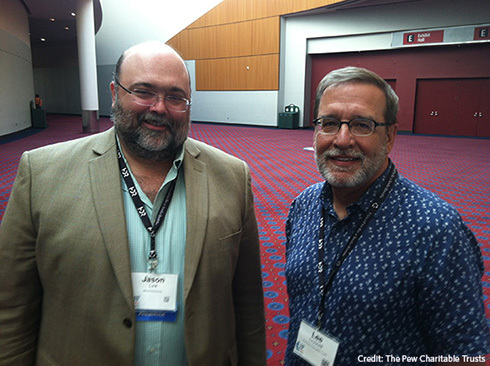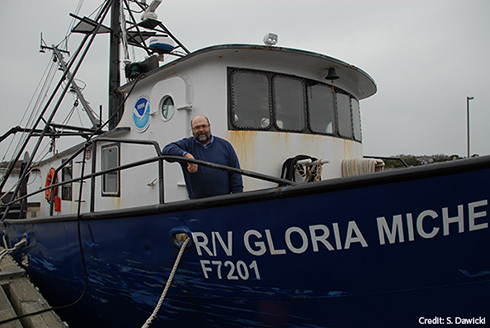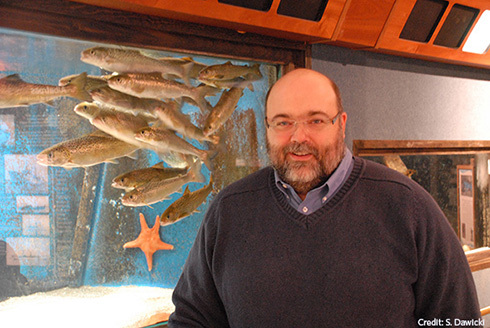Fish scientist Jason Link says he often feels like he's living the classic chocolate factory episode of the 1950s TV show I Love Lucy, in which Lucy and Ethel can't wrap candies as fast as the conveyor belt spits them out.
"It's analogous to fisheries management," says Link, whose mission at the National Oceanic and Atmospheric Administration's Fisheries Service (NOAA Fisheries) is to improve how ocean resources are regulated. "We're trying to keep up with rules on individual species whose populations are frequently changing. Our conveyor belt is moving faster and faster."
Jason Link (left) and Peter Auster, science director at Northeast Underwater Research Technology & Education Center at the University of Connecticut, hold barndoor skates while on the research vessel Albatross IV during a scientific mission on Georges Bank, off the New England coast.
Link's job--similar to mine at The Pew Charitable Trusts--is to advocate for a more effective, efficient approach to setting fishing rules, one that takes a big picture view. Instead of establishing catch limits on one species at a time, Link and I want decision-makers to focus on the ecosystem and consider what fish eat, what eats them, their habitat needs, and other conditions that affect fish populations. Our mission is to persuade people that a method called ecosystem-based fisheries management (EBFM) is the way to go.
"We've been managing fisheries on a species-by-species basis. We haven't been looking at the way that fish and other marine life interact with one another and the impacts on the broader system of removing one or more species from the mix," said Link, whom I've known for 10 years. "It's really clear we're missing information that could improve the way we're managing ocean ecosystems. The oceans are constantly changing. We need adaptive management tools to be able to handle these shifts, particularly climate change."
Link became interested in the ocean as a child when he found it fun to memorize the scientific names of sea creatures. He went on to earn a bachelor's degree in biology from Central Michigan University and a doctorate in biological sciences from Michigan Technological University.
After graduation, he debated whether to pursue a career in academia or a more hands-on scientific path. His choice became a little clearer after he attended both an academic conference and a fisheries meeting. At the conference, he engaged in research talk and was handed a pass for a wine and cheese reception followed by a ballet performance. The fisheries meeting featured on-the-water stories and a casual happy hour.
And so the down-to-earth outdoorsman chose what felt right. He's been with NOAA Fisheries for nearly 20 years, now in a position focused solely on promoting and researching ecosystem-based management. From his base at Woods Hole, Massachusetts, he spreads his message across the country to fishing groups, fishery leaders, academics, conservationists, scientists, and anyone else who will listen. He reports that most people agree that we need to shift to EBFM--but have questions on how to get it done.
Jason Link stands on the research vessel Gloria Michelle after docking in Woods Hole, Mass.
"The perception is that the technical basis for doing EBFM is beyond us. However, there are actually tools and methods that can allow us to implement it," says Link, who spent many years working on computer models that map out food webs to show how predators and prey interact. Link, who moves fluidly from discussing dense science with experts to using simpler language to carry his message, recently teamed up with a colleague to identify other misconceptions about EBFM in an article in the journal Fisheries, "Myths That Continue to Impede Progress in Ecosystem-Based Fisheries Management." It may not have been this summer's sizzling beach read, but in fish circles this was hot stuff.
1. Myth: No one knows what EBFM is or how to get it done.
Fact: The concept is getting more traction and is already in practice in some places. For example, protecting habitat or fish spawning sites are ways to implement EBFM.
2. Myth: The existing fishery management system has to change dramatically to incorporate EBFM.
Fact: More than 90 federal rules already allow for EBFM, and there is nothing to stop fish managers from incorporating it.
3. Myth: There's not enough scientific information on the ecosystem to know how to manage fisheries in a way that minimizes impacts to the environment.
Fact: It's not necessary to know every detail. The key is to consider more factors about the ecosystem--beyond just the status of one species--when setting fishing rules.
4. Myth: EBFM means fishermen will be allowed to catch fewer fish.
Fact: EBFM will improve the health of ecosystems, leading to more catch and stability in regulations and the economy.
5. Myth: This management theory is a naive attempt to steward fisheries in a contentious, political, and complex system.
Fact: EBFM is pragmatic because it helps managers meet objectives of multiple parties through an improved system of balancing trade-offs and the needs of all parties.
6. Myth: There aren't enough resources to make EBFM happen.
Fact: There is evidence to suggest that EBFM may actually reduce administrative complexity and the costs of fisheries management.
Put simply, Link says, EBFM should help address fishery issues that are only growing more complicated.
Taking the I Love Lucy comparison further he explains the importance of seeing the big picture. "Maybe chocolate isn't the only thing to worry about. Maybe we also have to deal with licorice or gum drops. And the room is warming. And the chocolate is melting, and there are more people coming into the room to eat it."
It's food analogies like this that help Link connect with his audiences. He's feeding his EBFM message to people far and wide. And I hope everyone is hungry to learn, because ecosystem-based fisheries management can help conserve our ocean resources while providing abundant fishing opportunities and seafood for generations to come.




